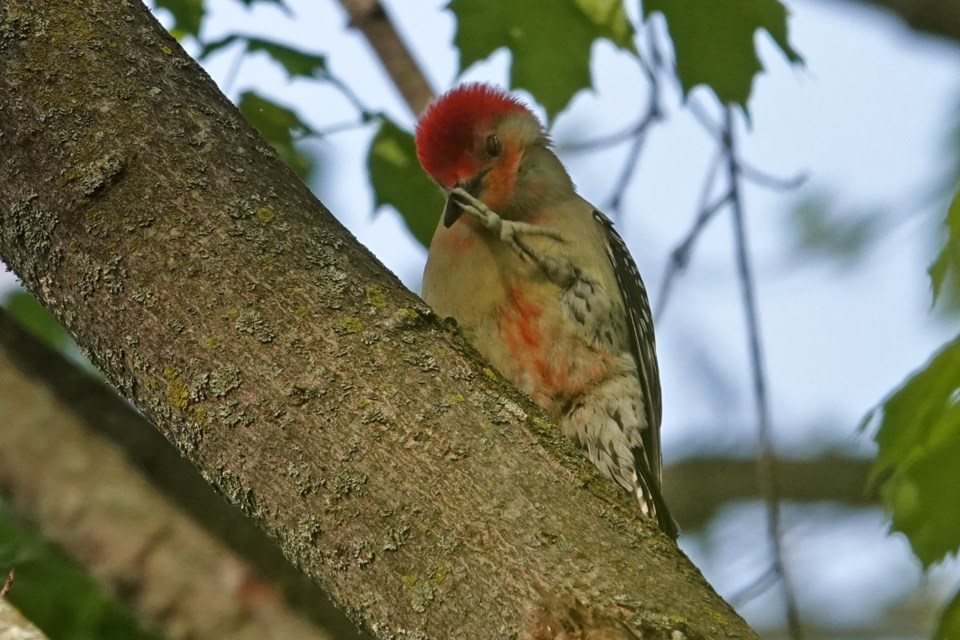I must admit that to have a rare bird plunk itself down on a tree limb right beside me, just as the camera was ready and pre-focused on another bird, was both startling and exciting. The surprise photo subject was a red-bellied woodpecker.
If you should go for a walk in most any of our local parks, nature reserves, conservation areas or County forests, there is a very good chance that you will see a woodpecker of some sort, as there are several species that hang out here in the summer. Most of these species are here year-round, but a couple disappear for the winter time.
Right now it is “almost guaranteed” that you will observe a downy woodpecker or its lager cousin the hairy woodpecker, or possibly a crow-sized pileated woodpecker, or a yellow-belled sapsucker, a red-headed woodpecker, or a yellow-shafted flicker. All are fairly common to our woodlots.
However, there is a relative newcomer to our region, a woodpecker that started out as an uncommon winter visitor but has now become a summer resident as well; I give you the red-bellied woodpecker.
Now if you have seen a rose-breasted grosbeak, a red-breasted nuthatch, a red-headed woodpecker or a yellow-bellied sapsucker, then you would have faith that a red-bellied woodpecker would have a similarly obvious reason for being bestowed with its common name. But it’s just not so with a red-bellied woodpecker.
If you are fortunate enough to find one, it will probably be hugging tight to the tree trunk or limb. You will easily see the beautiful red head-stripe and nape covering, but nary a pinkish feather will be seen on the undercarriage. Unless you get very lucky, as I did (see accompanying photograph).
So what makes this woodpecker so rare? Well, for thousands of years it didn’t live here, its home range being the mid-eastern States where it was quite common. About a dozen years ago the range map for this species suddenly changed shape, big time. A northern expansion took place with unprecedented haste.
Within the 1967 publication Birds of Simcoe County by O.E. Devitt, which is an excellent accounting of all bird species ever found in Simcoe County, the red-bellied woodpecker is not mentioned, not even once. Simply does not exist here.
Jump ahead less than 20 years, and the 1985 publication Atlas of the Breeding Birds of Ontario indicates that the red-bellied woodpecker has firmly established itself in the southern portions of our province… the very southern Carolinian forested area. No breeding behaviours noted in Simcoe County.
And when the second edition of the Atlas of Breeding Birds of Ontario hit our bookshelves in 2006, the red-bellied woodpecker had now rolled into central Ontario in great numbers. Your chance of seeing this species while out birdwatching had risen up to 600 per cent in some areas. That’s a significant rise in population!
However, a check in with the 1996 Atlas of the Breeding Birds of Quebec indicates that these woodpeckers were still 100 per cent absent from La Belle Province.
So what’s going on with these birds? Why the sudden and recent increase in visitation and duration of stay by these woodpeckers?
Adding to the mystery is that these birds were once fairly common in southern Ontario in the 1880s, although refined to the southern regions. Then their population crashed, and to see one in the 1890s was quite a big deal.
But in the 1970s, surprise, they came back! And have continued to move their breeding range northwards ever since.
There is the notion going around that the further north an individual is within its normal range, the larger the body size (to withstand the cold temps better). As the males tend to be a tad larger, they are the ones staying over the winter, and are luring the females northwards in the spring breeding season.
Of note in the photo above is a look at the unique toe placement of woodpeckers. Called zygodactyl placement (write that down on the inside of your Scrabble box lid) it shows two toes forward and two backwards, different than the usual three toes forward and one back as noted on most other species.
An observation from our backyard is that the male red-bellied woodpecker that has been hanging out at our feeders on-and-off over the winter, has taken a fancy to a female hairy woodpecker. There has been much chortling and feather fluffing displays observed over the last few weeks.
Will this lead to some Hairy-bellied Woodpeckers? We will keep watching.
